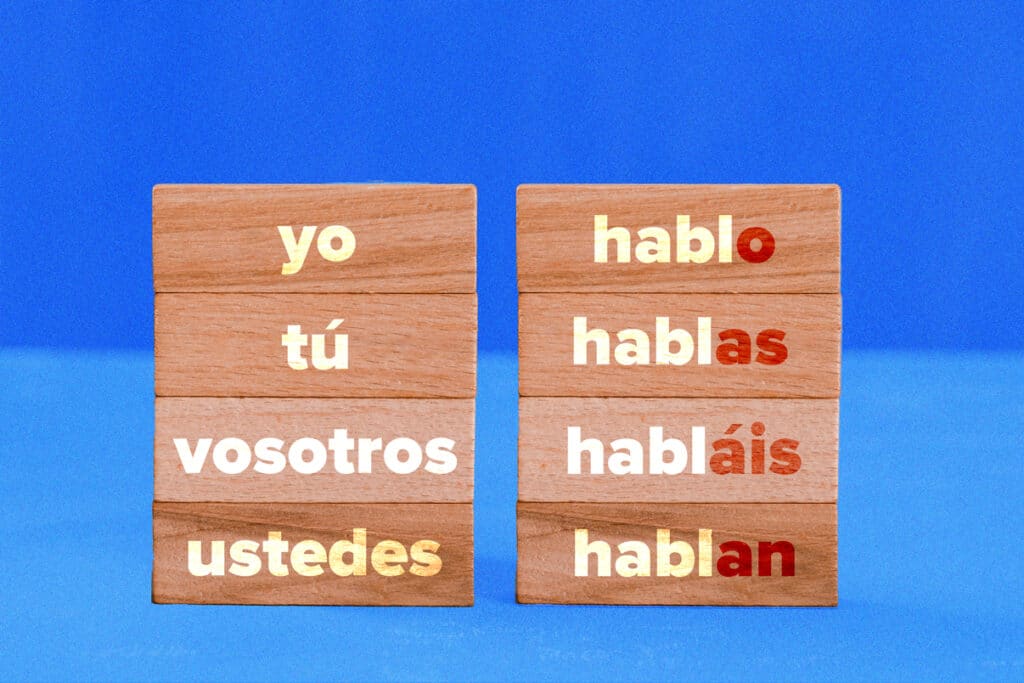Contents
- The Basics of Spanish Conjugation
- Conjugating Spanish Regular Verbs in the Present Tense
- Conjugating Spanish Reflexive Verbs in the Present Tense
- Conjugating Present Progressive Tense Spanish Verbs
- Conjugating Past Tense Spanish Verbs
- Conjugating Future Tense Spanish Verbs
- Conjugating Spanish Irregular Verbs
- How to Practice Conjugating Spanish Verbs
- And One More Thing…
Understanding Spanish Verb Conjugation

Spanish verbs change a lot more than English verbs. They change endings (and often stems, too) according to who is saying them, who (or what) you’re talking about, and whether you’re talking about the present, past or the future.
There is a bit to cover, so we’ll start with the most basic rules and then work through irregularities and the finer details of verb conjugation.
The Basics of Spanish Conjugation
When conjugating Spanish verbs in the present tense, you first need to identify who’s performing the action. This is your “subject.” There are eight possible subjects:
| Subject +Pronoun | Meaning |
|---|---|
| Yo / me | I / myself |
| Tú / te | You (informal) / yourself |
| Usted/ se | You (formal) / yourself |
| Él/Ella / se | He/She / himself/herself |
| Nosotros/Nosotras / nos | We / ourselves |
| Vosotros/Vosotras / os | You (plural informal) / yourselves |
| Ustedes / se | You (plural formal) / yourselves |
| Ellos/Ellas / se | They / themselves |
Now that we know who’s performing the action, we’ll need to conjugate by picking the correct verb ending depending on who the subject is.
All Spanish verb infinitives (the dictionary version of the verb) end in the letters -ar, -er or -ir.
To conjugate an infinitive, you need to remove the final two letters and add the appropriate ending.
To find the appropriate ending, you will need to consider which tense you’re using and whether the verb is regular or irregular.
Conjugating Spanish Regular Verbs in the Present Tense
The Spanish present tense is used for facts that are true in the current moment and general statements:
Yo quiero un gato. (I want a cat.)
Yo hablo español. (I speak Spanish.)
It’s the most basic and common Spanish tense, so it’s the perfect place for beginners to get started.
-ar verbs
Here’s how you’d conjugate hablar (to speak), which is a common –ar verb. You use the same verb endings to conjugate other regular -ar verbs.
| Subject | Ending | Hablar Conjugated |
|---|---|---|
| Yo | -o | hablo |
| Tú | -as | hablas |
| Usted/Él/Ella | -a | habla |
| Nosotros/as | -amos | hablamos |
| Vosotros/as | -áis | habláis |
| Ustedes/Ellos/Ellas | -an | hablan |
-er verbs
For regular -er verbs, such as comer (to eat):
| Subject | Ending | Comer Conjugated |
|---|---|---|
| Yo | -o | como |
| Tú | -es | comes |
| Usted/Él/Ella | -e | come |
| Nosotros/as | -emos | comemos |
| Vosotros/as | -éis | coméis |
| Ustedes/Ellos/Ellas | -en | comen |
-ir verbs
For regular -ir verbs, such as vivir (to live):
| Subject | Ending | Vivir Conjugated |
|---|---|---|
| Yo | -o | vivo |
| Tú | -es | vives |
| Usted/Él/Ella | -e | vive |
| Nosotros/as | -imos | vivimos |
| Vosotros/as | -ís | vivís |
| Ustedes/Ellos/Ellas | -en | viven |
Here are a few examples of this tense in action:
Antonio canta por las mañanas. (Antonio sings in the mornings.)
Mi sobrino come mucho. (My nephew eats a lot.)
Patricia vive en Madrid. (Patricia lives in Madrid.)
Conjugating Spanish Reflexive Verbs in the Present Tense
Reflexive verbs perform an action on themselves. That is, they have a subject that’s the same as the object, such as in the sentence “I weigh myself” or “I wash myself.”
You can spot these in Spanish because their infinitive verb form often includes a pronoun, for example:
- lavarse (to wash oneself)
- bañarse (to bathe oneself)
- despertarse (to wake oneself up)
To conjugate reflexive verbs, you’ll also need to choose the appropriate reflexive pronoun, to indicate the subject/object relationship.
The following reflexive pronouns can be used for reflexive verbs in any tense:
| Subject +Pronoun | Meaning |
|---|---|
| Yo / me | I / myself |
| Tú / te | You (informal) / yourself |
| Usted/ se | You (formal) / yourself |
| Él/Ella / se | He/She / himself/herself |
| Nosotros/Nosotras / nos | We / ourselves |
| Vosotros/Vosotras / os | You (plural informal) / yourselves |
| Ustedes / se | You (plural formal) / yourselves |
| Ellos/Ellas / se | They / themselves |
You’ll typically place the reflexive pronoun right before the conjugated verb.
Here are some examples:
Pedro se ducha todos los días. (Pedro showers [himself] every day.)
Siempre me acuesto a las 10. (I always go to bed at 10 p.m.)
¿Por qué no te afeitas? (Why don’t you shave [yourself]?)
Conjugating Present Progressive Tense Spanish Verbs
The present progressive tense is used to refer to actions happening right now. In the English language, this would refer to verbs ending in -ing.
To form sentences in the present progressive, you must first know how to conjugate the verb estar (to be):
| Subject | Conjugation |
|---|---|
| Yo | estoy |
| Tú | estás |
| Usted/Él/Ella | está |
| Nosotros/as | estamos |
| Vosotros/as | estáis |
| Ustedes/Ellos/Ellas | están |
Then, change the ending of the action verb as follows:
- -ar to -ando
- -er/ir to -iendo
Let’s look at escribir (to write) as an example. To say “I am writing” in Spanish, we will:
- Conjugate estar in the yo form→ estoy.
- Change the ending of escribir→ escribiendo.
- Combine the two to get Estoy escribiendo (I am writing).
Here are a few more examples:
Mi vecino está llorando. (My neighbor is crying.)
Estamos bebiendo café. (We’re drinking coffee.)
Estoy escribiendo un correo electrónico. (I’m writing an email.)
Conjugating Past Tense Spanish Verbs
The past tense, or the preterite, refers to the simplest form of the Spanish past tense. In English, conjugating to the past tense would typically involve adding the suffix -ed to a verb.
Basically, use this tense to talk about things that have already happened and are completed.
-ar verbs
The following table will show you how to conjugate -ar verbs in the past tense:
| Subject | Ending | Hablar Conjugated |
|---|---|---|
| Yo | -é | hablé |
| Tú | -aste | hablaste |
| Usted/Él/Ella | -ó | habló |
| Nosotros/as | -amos | hablamos |
| Vosotros/as | -asteis | hablasteis |
| Ustedes/Ellos/Ellas | -aron | hablaron |
-er / -ir verbs
In this verb tense, the -er and -ir forms have the same ending:
| Subject | Ending | Comer/Vivir Conjugated |
|---|---|---|
| Yo | -í | comí viví |
| Tú | -iste | comiste viviste |
| Usted/Él/Ella | -ió | comió vivió |
| Nosotros/as | -imos | comimos vivimos |
| Vosotros/as | -isteis | comisteis vivisteis |
| Ustedes/Ellos/Ellas | -ieron | comieron vivieron |
Note the placement of accents in this verb tense: They’re important but are only used for the first and third person.
Here are a few examples:
Anabel comiópizza anoche. (Anabel ate pizza last night.)
Vivieron 10 años en Buenos Aires. (They lived in Buenos Aires for 10 years.)
Ayer llamamosa nuestra abuela. (We called our grandma yesterday.)
Conjugating Future Tense Spanish Verbs
Many consider the future tense to be one of the easiest to conjugate in Spanish.
When you conjugate Spanish verbs to the future tense, you simply add the ending to the end of the infinitive form of a verb. The ending will be the same for all verbs.
Here are the verb endings for the future tense:
| Subject | Ending | Examples |
|---|---|---|
| Yo | -é | hablaré comeré viviré |
| Tú | -ás | hablarás comerás vivirás |
| Usted/Él/Ella | -á | hablará comerá vivirá |
| Nosotros/as | -emos | hablaremos comeremos viviremos |
| Vosotros/as | -éis | hablaréis comeréis viviréis |
| Ustedes/Ellos/Ellas | -án | hablarán comerán vivirán |
Check out a few more examples of the future tense at work:
Mañana lloverá. (It’ll rain tomorrow.)
Serásmuy feliz aquí. (You’ll be very happy here.)
Iremosa dormir muy pronto. (We’ll go to sleep very soon.)
Note that the future tense is reserved for a slightly more distant future. This tense is often not used for something that will happen in the very near future (as in hours or minutes).
When something is happening relatively soon, but still somewhat in the future, you’d more often use the present tense, or the ir + a + infinitive form, to describe this, like this example:
Voy a nadar hoy. (I’m going swimming today.)
Conjugating Spanish Irregular Verbs
Unfortunately, in Spanish, many verbs don’t follow the rules of conjugation that we’ve covered. These are called irregular verbs.
Irregular verbs are very common and in most cases, you’ll just have to memorize their special conjugations.
There are four main types of irregular verbs.
Stem-changing Verbs
Stem-changing verbs have the same conjugations as regular verbs. Their irregularity is seen when their stem—the part that remains when you drop the -ar/-er/-ir ending— changes.
There are four main types of stem changes that can occur:
- E → IE
- O → UE
- E → I
- U → UE
This is what those stem changes would look like using the yo form as an example:
- Querer → Quiero
- Poder → Puedo
- Decir — Digo
- Jugar — Juego
Note that these stem changes don’t apply to the nosotros and vosotros forms.
Irregular Yo Forms
Some verbs are only irregular when you conjugate them to their yo (I) form. There are various kinds of verbs that have irregular yo forms.
- Some verbs will end in -go, -oy, or -zco.
- Verbs that end in -ger or -gir will end in -jo.
These are only a few of the patterns and the only way to really remember them is to memorize these.
Here are a few examples of verbs with irregular yo forms. Note that three of the most common Spanish verbs (ser, saber and ir) are included in this list.
- Salgo (I leave)
- Soy (I am)
- Conozco (I know)
- Sé (I know)
- Extingo (I extinguish)
- Escojo (I choose)
- Voy (I go)
Spelling-change Verbs
Some verbs change their spelling when they’re conjugated a certain way. You can see an example of this with -uir words. This is done to maintain the proper pronunciation.
They’re conjugated normally for the most part, but the i becomes y in all forms except for nosotros and vosotros.
Here are some examples:
- incluir (to include) → ella incluye (she includes)
- huir (to run away) → ellos huyen (they run away)
- destruir (to destroy) → yo destruyo (I destroy)
Another example is verbs ending in -cer and -cir. To keep the “th” sound, the letter z is used in the first person conjugation (I).
If there’s a consonant before -cer / -cir, the c changes into a z:
- vencer (to defeat) → yo venzo (I defeat)
If there’s a vowel before -cer / -cir, the z is added before the c:
- producir (to produce) → yo produzco (I produce)
Special Irregular Verbs
There are some special irregular verbs that just completely drop all rules and do their own thing. It’s best to just memorize these verbs and forms.
Two of the most common verbs with special irregular forms that you need to remember are ser (to be) and ir (to go).
Here’s how you conjugate ser in the present tense:
| Subject | Conjugation |
|---|---|
| Yo | soy |
| Tú | eres |
| Usted/Él/Ella | es |
| Nosotros/as | somos |
| Vosotros/as | sois |
| Ustedes/Ellos/Ellas | son |
And here’s how you conjugate ir in the present tense:
| Subject | Conjugation |
|---|---|
| Yo | voy |
| Tú | vas |
| Usted/Él/Ella | va |
| Nosotros/as | vamos |
| Vosotros/as | vais |
| Ustedes/Ellos/Ellas | van |
How to Practice Conjugating Spanish Verbs
If you’re just getting started, learning how to conjugate Spanish verbs can be a bit overwhelming.
If it’s not instant recall yet (and it won’t be for a while), the following techniques and tools can help you to bridge the gap.
For starters, you can create three sets of flashcards for super-efficient practice:
- Subject pronouns
- Tenses
- Infinitive verbs
Choose a card from each set at random and test your ability to conjugate Spanish verbs on the go. This will help you to develop conversational fluency with quick recall.

For a high-tech version of this, Spanish411 offers an online tool for practicing verb conjugations.
If you want to see how verbs are conjugated and used in natural speech, you can also check out FluentU.
FluentU takes authentic videos—like music videos, movie trailers, news and inspiring talks—and turns them into personalized language learning lessons.
You can try FluentU for free for 2 weeks. Check out the website or download the iOS app or Android app.
P.S. If you decide to sign up now, you can take advantage of our current sale!

Learning Spanish verb conjugations is part practice and part memorization.
You’ll conjugate hundreds of verbs before finally feeling like you’re getting the hang of things, but with time, conjugation will come naturally.
Download: This blog post is available as a convenient and portable PDF that you can take anywhere. Click here to get a copy. (Download)
And One More Thing…
If you've made it this far that means you probably enjoy learning Spanish with engaging material and will then love FluentU.
Other sites use scripted content. FluentU uses a natural approach that helps you ease into the Spanish language and culture over time. You’ll learn Spanish as it’s actually spoken by real people.
FluentU has a wide variety of videos, as you can see here:

FluentU brings native videos within reach with interactive transcripts. You can tap on any word to look it up instantly. Every definition has examples that have been written to help you understand how the word is used. If you see an interesting word you don’t know, you can add it to a vocab list.

Review a complete interactive transcript under the Dialogue tab, and find words and phrases listed under Vocab.

Learn all the vocabulary in any video with FluentU’s robust learning engine. Swipe left or right to see more examples of the word you’re on.

The best part is that FluentU keeps track of the vocabulary that you’re learning, and gives you extra practice with difficult words. It'll even remind you when it’s time to review what you’ve learned. Every learner has a truly personalized experience, even if they’re learning with the same video.
Start using the FluentU website on your computer or tablet or, better yet, download the FluentU app from the iTunes or Google Play store. Click here to take advantage of our current sale! (Expires at the end of this month.)







